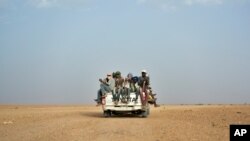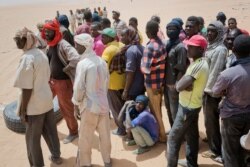A new report says thousands of African refugees and migrants die or face abuse while traveling across the Sahara Desert toward Libya and the gateway to Europe. The report by the U.N. refugee agency and the Mixed Migration Center at the Danish Refugee Council describes the harrowing journeys taken by east and west African irregular migrants along the migratory route.
Around 16,000 refugees and migrants surveyed over the last two years have described brutality and inhumanity suffered at the hands of smugglers, traffickers, militias and even government officials.
The U.N. refugee agency special envoy for the central Mediterranean, Vincent Cochetel, said 47 percent of the victims have reported that the perpetrators of violence were law enforcement authorities.
“Whereas in the past, we believed that it was mainly smugglers and traffickers — yes, they are key perpetrators of violence — but the primary perpetrators of violence are people who are supposed to protect,” Cochetel said.
The report documents at least 72 deaths a month for a total of 1,750 fatalities in 2018 and 2019, making the desert route one of the deadliest in the world. Authors of the report suggest the number is greatly underestimated.
Ayala Erin Bonfilio, regional coordinator for the Mixed Migration Center North Africa, said 43 percent of refugees and migrants surveyed in Libya cited it as the most dangerous country on the migratory route, followed by Niger, Algeria and Mali.
“The main threats in Libya include physical violence followed by detention, death, robberies and sexual violence. … Men are more vulnerable compared to women. However, women were considerably more likely to experience or witness sexual abuse. And the reason for men being more vulnerable on the whole could, for instance in the case of detention, be related to the fact that detention was linked to forced labor, so they were commodified,” Bonfilio said.
The report says the migrants and refugees who survive abuse en route are often left with severe mental health issues.
Thousands of men, women and children who arrive in Libya and make the sea crossing to Europe are intercepted by the Libyan Coast Guard and returned to Libya. Many are held in official government detention centers, where they reportedly face abuse.
Many others, the report says, end up in unofficial centers or warehouses controlled by smugglers and traffickers who physically abuse them to extract payments for their release.
The refugee and migration agencies say these vulnerable people should under no circumstances be returned to Libya, as it is not safe.









